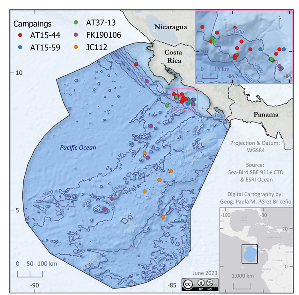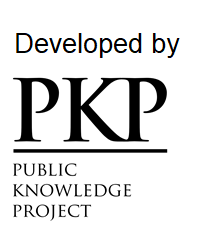Characterizing the Oxygen Minimum Zone (OMZ) in the Costa Rican Eastern Tropical Pacific using in situ data from field campaigns
DOI:
https://doi.org/10.47193/mafis.37X2024010111Keywords:
Anoxia, international collaboration, Central America, methane seeps, continental margin, CTD profilesAbstract
For conservation and sustainable fisheries, it is important to characterize the Oxygen Minimum Zones or OMZ in and around the methane seeps of the Eastern Tropical Pacific (ETP), Costa Rica, through the analysis of temperature, salinity, density, and oxygen profiles. The data used in this work were collected during several oceanographic research campaigns in the Pacific continental margin and offshore of Costa Rica, between 2009 and 2019, using a CTDs, as the profiler of physical parameters of the water column. In general, it was observed that dissolved oxygen gradually decreases with depth to the thermocline, then its concentration decreases more rapidly and remains low, indicating the presence of the OMZ and tends to increase slightly at greater depths. Mean vertical extension of the OMZ near and around the seeps was 763 m and the mean depth for the minimum dissolved oxygen value was 393 m. Spatial differences of measurements taken at stations near the methane seeps were calculated with respect to the measurements at the station located above them. Overall, a greater variability of the oxygen anomalies was observed within the mixed layer, while under the thermocline their values remain stable and around zero.
Downloads
Metrics
References
Alfaro E, Lizano O. 2001. Algunas relaciones entre las zonas de surgencia del Pacífico Centroamericano y los Océanos Pacífico y Atlántico Tropical. Rev Biol Trop. 49 (2): 185-193. https://www.kerwa.ucr.ac.cr/handle/10669/76681.
Amador JA, Rivera ER, Durán-Quesada AM, Mora G, Sáenz F, Calderón B, Mora N. 2016a. The easternmost tropical Pacific. Part I: a climate review. Rev Biol Trop. 64 (1): 1-22. DOI: https://doi.org/10.15517/rbt.v64i1.23407
Amador JA, Durán-Quesada AM, Rivera ER, Mora G, Sáenz F, Calderón B, Mora N. 2016b. The easternmost tropical Pacific. Part II: seasonal and intraseasonal modes of atmospheric variability. Rev Biol Trop. 64 (1): 23-57. DOI: https://doi.org/10.15517/rbt.v64i1.23409
Breitburg D, Levin LA, Oschlies A, Grégoire M, Chavez FP, Conley DJ, Garçon V, Gilbert D, Gutiérrez D, Isensee K, et al. 2018. Declining oxygen in the global ocean and coastal waters. Science. 359 (6371): eaam7240. DOI: http://doi.org/10.1126/science.aam7240
Brenes CL, Coen JE. 1985. Correlación T-S de las masas de agua en la región del Domo Térmico de Costa Rica. Uniciencia. 2 (1): 41-50. https://www.revistas.una.ac.cr/index.php/uniciencia/article/view/5350.
Brenes CL, Ballestero D, Benavides R, Salazar, JP, Murillo, G. 2016. Variations in the geostrophic circulation pattern and thermohaline structure in the Southeast Central American Pacific. Rev Biol Trop. 64 (2): 121-134. DOI: https://doi.org/10.15517/rbt.v64i1.23421
Cabré A, Marinov I, Bernardello R, Bianchi D. 2015. Oxygen minimum zones in the tropical Pacific across CMIP5 models: mean state differences and climate change trends. Biogeosciences. 12 (18): 5429-5454. DOI: https://doi.org/10.5194/bg-12-5429-2015
Czeschel R, Stramma L, Johnson, G C. 2012. Oxygen decreases and variability in the eastern equatorial Pacific. J Geophys Res C Oceans. 117: C11019. DOI: https://doi.org/10.1029/2012JC008043
Dale AW, Sommer S, Lomnitz U, Montes I, Treude T, Liebetrau V, Gier J, Hensen C, Dengler M, Stolpovsky K, et al. 2015. Organic carbon production, mineralisation and preservation on the Peruvian margin. Biogeosciences. 12 (5): 1537-1559. DOI: https://doi.org/10.5194/bg-12-1537-2015
Deutsch C, Brix H, Ito T, Frenzel H, Thompson, L. 2011. Climate-forced variability of ocean hypoxia. Science. 333 (6040): 336-339. DOI: http://doi.org/10.1126/science.1202422
DeVries T, Deutsch C, Rafter PA, Primeau F. 2013. Marine denitrification rates determined from a global 3-D inverse model. Biogeosciences. 10: 2481-2496. DOI: http://doi.org/10.5194/bg-10-2481-2013
Durán-Quesada AM, Sorí R, Ordoñez P, Gimeno L. 2020. Climate perspectives in the intra-Americas Seas. Atmosphere-Basel. 11 (9): 959. DOI: https://doi.org/10.3390/atmos11090959
Duteil O, Oschlies A, Böning, CW. 2018. Pacific Decadal Oscillation and recent oxygen decline in the eastern tropical Pacific Ocean. Biogeosciences. 15 (23): 7111-7126. DOI: https://doi.org/10.5194/bg-15-7111-2018
Enfield DB. 1987. The intraseasonal oscillation in eastern Pacific Sea levels: How is it forced? J Phys Oceanogr. 17: 1860-1876. DOI: https://doi.org/10.1175/1520-0485(1987)017<1860:TIOIEP>2.0.CO;2
Escoto-Murillo A, Alfaro EJ. 2021. Análisis de eventos fríos y cálidos por medio de datos de buceo: un enfoque de ciencia ciudadana en el Golfo de Papagayo, Costa Rica. Rev Biol Trop. 69 (2): 94-104. DOI: https://doi.org/10.15517/rbt.v69iSuppl.2.48309
Espinoza-Morriberón D, Echevin V, Colas F, Tam J, Gutierrez D, Graco M, Ledesma J, Quispe-Ccalluari C. 2019. Oxygen variability during ENSO in the tropical South Eastern Pacific. Front Mar Sci. 5: 526. DOI: https://doi.org/10.3389/fmars.2018.00526
Fee EA. 2012. Extent of the oxygen minimum zone in the Eastern Tropical North Pacific [thesis]. Proceedings from the University of Washington. School of Oceanography, Academic Year 2011-2012. 8 p. http://hdl.handle.net/1773/20061.
Fiedler PC, Mendelssohn R, Palacios DM, Bograd SJ. 2013. Pycnocline variations in the eastern tropical and North Pacific, 1958-2008. J Climate. 26 (2): 583-599. DOI: https://doi.org/10.1175/JCLI-D-11-00728.1
Fiedler PC, Talley LD. 2006. Hydrography of the eastern tropical Pacific: a review. Prog Oceanog. 69 (2-4): 143-180. DOI: https://doi.org/10.1016/j.pocean.2006.03.008
Fu W, Bardin A, Primeau F. 2018. Tracing ventilation source of tropical Pacific oxygen minimum zones with an adjoint global ocean transport model. Deep-Sea Res Pt I. 139: 95-103. DOI: https://doi.org/10.1016/j.dsr.2018.07.017
Fuenzalida R, Schneider W, Garcés-Vargas J, Bravo L, Lange C. 2009. Vertical and horizontal extension of the oxygen minimum zone in the eastern South Pacific Ocean. Deep-Sea Res Pt II. 56 (16): 992-1003. DOI: https://doi.org/10.1016/j.dsr2.2008.11.001
García-Franco JL, Chadwick R, Gray LJ, Osprey S, Adams DK. 2023. Revisiting mechanisms of the Mesoamerican Midsummer drought. Clim Dyn. 60: 549-569. DOI: https://doi.org/10.1007/s00382-022-06338-6
Glud RN, Grossart HP, Larsen M, Tang KW, Arendt KE, Rysgaard S, Thamdrup B, Nielsen TG. 2015. Copepod carcasses as microbial hot spots for pelagic denitrification. Limnol Oceanog. 60 (6): 2026-2036. DOI: https://doi.org/10.1002/lno.10149
Gooday AJ, Bett BJ, Escobar E, Ingole B, Levin LA, Neira C, Raman AV, Sellanes, J. 2010. Habitat heterogeneity and its influence on benthic biodiversity in oxygen minimum zones. Mar Ecol. 31 (1): 125-147. DOI: http://doi.org/10.1111/j.1439-0485.2009.00348.x
Gruber N, Lachkar Z, Frenzel H, Marchesiello P, Münnich M, McWilliams JC, Nagai T, Plattner, GK. 2011. Eddy-induced reduction of biological production in eastern boundary upwelling systems. Nat Geosci. 4 (11): 787-792. DOI: https://doi.org/10.1038/ngeo1273
Helly JJ, Levin LA. 2004. Global distribution of naturally occurring marine hypoxia on continental margins. Deep-Sea Res Pt I. 51 (9): 1159-1168. DOI: https://doi.org/10.1016/j.dsr.2004.03.009
Ito T, Deutsch C. 2013. Variability of the oxygen minimum zone in the tropical North Pacific during the late twentieth century. Global Biogeochem Cycles. 27 (4): 1119-1128. DOI: https://doi.org/10.1002/2013GB004567
Ito T, Long MC, Deutsch C, Minobe S, Sun D. 2019. Mechanisms of low-frequency Oxygen variability in the North Pacific. Global Biogeochem Cycles. 33 (2): 110-124. DOI: https://doi.org/10.1029/2018GB005987
Karstensen J, Stramma L, Visbeck M. 2008. Oxygen minimum zones in the eastern tropical Atlantic and Pacific oceans. Prog Oceanog. 77 (4): 331-350. DOI: https://doi.org/10.1016/j.pocean.2007.05.009
Kirchman DL. 2021. Dead Zones: The loss of oxygen from rivers, lakes, seas, and the ocean. New York: Oxford University Press. 217 p.
Levin LA. 2002. Deep-ocean life where oxygen is scarce. Am Sci. 90 (5): 436-444. DOI: https://doi.org/10.1511/2002.33.436
Levin LA. 2003. Oxygen minimum zone benthos: adaptation and community response to hypoxia. In: GIBSON RN, ATKINSON RJA, editors. Oceanography and marine biology, an annual review. 41. London: CRC Press. p. 1-45.
Levin LA, Orphan VJ, Rouse GW, Rathburn AE, Ussler W, Cook GS, Goffredi SK, Perez EM, Waren A, Grupe BM, Chadwick G, Strickrott B. 2012. A hydrothermal seep on the Costa Rica margin: middle ground in a continuum of reducing ecosystems. Proc R Soc B. 279: 2580-2588. DOI: http://doi.org/10.1098/rspb.2012.0205
Lizano OG. 2016. Distribución espacio-temporal de la temperatura, salinidad y oxígeno disuelto alrededor del Domo Térmico de Costa Rica. Rev Biol Trop. 64 (1): 135-152. DOI: https://doi.org/10.15517/rbt.v64i1.23422
Loescher CR, Bange HW, Schmitz RA, Callbeck CM, Engel A, Hauss H, Kanzow T, Kiko R, Lavik G, Loginova A, et al. 2016. Water column biogeochemistry of oxygen minimum zones in the eastern tropical North Atlantic and eastern tropical South Pacific oceans. Biogeosciences. 13 (12): 3585-3606. DOI: https://doi.org/10.5194/bg-13-3585-2016
Matear RJ, Hirst AC. 2003. Long-term changes in dissolved oxygen concentrations in the ocean caused by protracted global warming. Global Biogeochem Cycles. 17 (4): 1125. DOI: https://doi.org/10.1029/2002GB001997
Mora-Escalante RE, Lizano OG, Alfaro EJ, Rodríguez A. 2020. Distribución de temperatura y salinidad en campañas oceanográficas recientes en el Pacífico Tropical Oriental de Costa Rica. Rev Biol Trop. 68 (1): 177-197. DOI: https://doi.org/10.15517/rbt.v68iS1.41180
Neira C, Ingels J, Mendoza G, Hernandez-Lopez E, Levin LA. 2018. Distribution of meiofauna in bathyal sediments influenced by the Oxygen Minimum Zone off Costa Rica. Front Mar Sci. 5: 448. DOI: http://doi.org/10.3389/fmars.2018.00448
Oschlies A, Schulz KG, Riebesell U, Schmittner A. 2008. Simulated 21st century’s increase in oceanic suboxia by CO2-enhanced biotic carbon export. Global Biogeochem Cycles. 22 (4): GB4008. DOI: https://doi.org/10.1029/2007GB003147
Paulmier A, Ruiz-Pino D. 2009. Oxygen minimum zones (OMZs) in the modern ocean. Prog Oceanog. 80 (3-4): 113-128. DOI: http://doi.org/10.1016/j.pocean.2008.08.001
Rixen T, Cowie G, Gaye B, Goes J, do Rosário Gomes H, Hood RR, Lachkar Z, Schmidt H, Segschneider J, Singh A. 2020. Reviews and syntheses: present, past, and future of the oxygen minimum zone in the northern Indian Ocean. Biogeosciences. 17 (23): 6051-6080. DOI: https://doi.org/10.5194/bg-17-6051-2020
Rodríguez A, Alfaro EJ, Cortés J. 2021. Spatial and temporal dynamics of the hydrology at Salinas Bay, Costa Rica, Eastern Tropical Pacific. Rev Biol Trop. 69 (2): 105-126. DOI: https://doi.org/10.15517/rbt.v69iSuppl.2.48314
Ross-Salazar E, Jiménez-Ramón JA, Castro-Campos M, Blanco-Bolaños M. 2019. Atlas Domo Térmico de Costa Rica. San José: Fundación MarViva. 108 p. https://marviva.net/atlas-del-domo-termico-de-costa-rica/.
Sarma VVSS, Bhaskar TU, Kumar JP, Chakraborty K. 2020. Potential mechanisms responsible for occurrence of core oxygen minimum zone in the north-eastern Arabian Sea. Deep-Sea Res Pt I. 165: 103393. DOI: https://doi.org/10.1016/j.dsr.2020.103393
Sea-Bird Electronics. 2013. SBE 43 Dissolved oxygen sensor: application note no. 64. https://www.seabird.com.
Sea-Bird Electronics. 2016. Seasoft V2 SBE Data processing: software manual. https://www.seabird.com.
Stief P, Lundgaard ASB, Morales-Ramírez Á, Thamdrup B, Glud RN. 2017. Fixed-nitrogen loss associated with sinking zooplankton carcasses in a coastal oxygen minimum zone (Golfo Dulce, Costa Rica). Front Mar Sci. 4: 152. DOI: https://doi.org/10.3389/fmars.2017.00152
Stramma L, Johnson GC, Firing E, Schmidtko S. 2010. Eastern Pacific oxygen minimum zones: supply paths and multidecadal changes. J Geophys Res-Oceans. 115: C09011. DOI: https://doi.org/10.1029/2009JC005976
Stramma L, Johnson GC, Sprintall J, Mohrholz V. 2008. Expanding oxygen-minimum zones in the tropical oceans. Science. 320 (5876), 655-658. DOI: https://doi.org/10.1126/science.1153847
Stramma L, Oschlies A, Schmidtko S. 2012. Mismatch between observed and modeled trends in dissolved upper-ocean oxygen over the last 50 yr. Biogeosciences. 9 (10): 4045-4057. DOI: https://doi.org/10.5194/bg-9-4045-2012
Trucco-Pignata PN, Hernández-Ayón JM, Santamaria-del-Angel E, Beier E, Sánchez-Velasco L, Godínez VM, Norzagaray O. 2019. Ventilation of the upper oxygen minimum zone in the coastal region off Mexico: implications of El Niño 2015-2016. Front Mar Sci. 6: 459. DOI: https://doi.org/10.3389/fmars.2019.00459
Van Rossum G, Drake FL. 2009. Python 3 reference manual. Scotts Valley: CreateSpace. DOI: https://dl.acm.org/doi/book/10.5555/1593511
Wyrtki K. 1967. Circulation and water masses in the Eastern Equatorial Pacific Ocean. Int J Oceanol Limnol. 1 (2): 117-147. ftp://mananui.soest.hawaii.edu/pub/rlukas/Klaus/papers/Wyrtki1967%20IJOL.pdf.

Published
How to Cite
Issue
Section
License
Copyright (c) 2024 Alejandro Rodríguez, Erick J. Alfaro, Jorge Cortés

This work is licensed under a Creative Commons Attribution-NonCommercial-ShareAlike 4.0 International License.
Authors of articles published in Marine and Fishery Sciences retain copyright on their articles, except for any third-party images and other materials added by Marine and Fishery Sciences, which are subject to copyright of their respective owners. Authors are therefore free to disseminate and re-publish their articles, subject to any requirements of third-party copyright owners and subject to the original publication being fully cited. Visitors may also download and forward articles subject to the citation requirements. The ability to copy, download, forward or otherwise distribute any materials is always subject to any copyright notices displayed. Copyright notices must be displayed prominently and may not be obliterated, deleted or hidden, totally or partially.
This journal offers authors an Open Access policy. Users are allowed to read, download, copy, distribute, print, search, or link to the full texts of the articles, or use them for any other legal purpose within the Creative Commons 4.0 license (BY-NC-SA), without asking prior permission from the publisher or the author. This is in accordance with the BOAI definition of Open Access.































